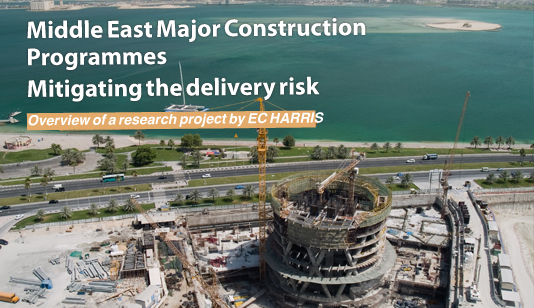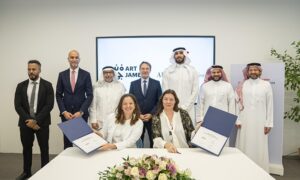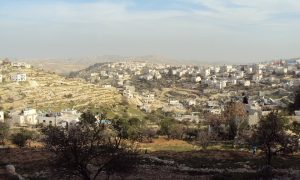Middle East Major Construction Programmes
Mitigating the delivery risk
Overview of a research project by EC HARRIS
Introduction
The Middle East is set to experience unparalleled construction activity over the next decade.
Countries in the Cooperation Council for the Arab States of the Gulf, also known as the Gulf Cooperation Council, have impressive national development plans to diversify their economies, reducing their reliance on oil and gas reserves, and a desire to be recognised on the world stage.
In order to deliver these plans, a huge number of construction and infrastructure programmes will need to be undertaken in the coming decade. ‘Major programmes’, which we define as construction programmes that cost more than US$1billion and need to be delivered in a relatively short period of time, are critical aspects of these development plans.
This report focuses on planned major programmes across six Middle East countries. It quantifies the sheer scale of the programmes already planned and identifies the main issues that have the potential to impact the successful completion of these ambitious construction programmes.
Why major programmes could be at risk
There will be intense competition between Middle East countries, as well as with other emerging markets, for the necessary labour and material resource to deliver these major programmes with major demand peaks overlapping key programmes.
International contractors winning major programme contracts in the Middle East may find it difficult to attract unskilled labour and skilled construction professionals on the scale required to successfully complete contracts on time.
With demand currently outstripping supply for human capital and material resources, there is risk of inflationary price rises driven by the need to secure resources in a very competitive and intense market. A coordinated national approach to regulation, planning controls, employment policies and bureaucracy is necessary to remain competitive.
Those countries that have the existing social infrastructure to support expat migrants will be best placed to keep major programmes on track.
Countries included within the study: Iraq, Kingdom of Saudi Arabia, Kuwait, Oman, Qatar and United Arab Emirates (UAE)
Sectors included: property (residential and commercial); energy (oil and gas) and power (coal, gas, nuclear, solar); and infrastructure transportation, education, hospitals, and water.
Across the region, the research identified 117 major programmes that are planned for completion by 2030, costing in excess of US$1 trillion. They involve a combination of retail, real estate, leisure, health and education asset developments as well as transport, communication and supporting social infrastructure systems.
Projects valued over US$10 billion
Over three quarters of the major programmes analysed are valued at over US$10 billion including ‘new city’ developments, for example, King Abdullah Economic City (KSA), Lusail City (Qatar), Basra New City (Iraq) and Mohammad Bin Rashid City (UAE). The Oman Rail and Kuwait Metro developments and several energy projects are also all expected to be built in five years or less.
To meet the fixed deadlines of global events in the region, such as the FIFA World Cup 2022™ in Qatar, and the National Vision plans, rapid project commitment is expected in the next three years with almost two thirds of spend scheduled between 2014 and 2016 with a peak of US$144 billion in construction in 2016. In fact, 95% of major programmes in Iraq are scheduled in the peak period, as are 90% of Oman’s and 79% of Qatar’s projects, raising significant questions around feasibility, impact on social infrastructure and labour capacity. The US$640 billion to be spent in the six years between 2014 and 2019 on major programmes does not include the other infrastructure and project commitments in the region (those under US$1 billion in value), placing further pressures on already stretched human and material resource requirements.
Peak of Activities
Programmes across the region will result in a very substantial peak of activity commencing in 2014. History has shown that major programmes are often subject to scope change, delay and, in the worst cases, contract dispute. Estimated costs and values at launch are likely to rise over time as risks materialise, delays occur, material and labour costs rise and plant may no longer be available.
Many of the major programmes have been formally announced, but have not yet started on site and therefore spend patterns could well shift over time. The ability to ‘shoulder’ workload over the critical 2014 to 2019 period will enable some clients to reduce their exposure to extreme market conditions – albeit at the cost of delayed delivery.
Trends – ‘New cities’ driving major developments
City and Commercial property developments account for nearly half of all major programmes’ spend ‘New cities’ are the most ambitious programmes; they are major economic or social developments comprising many individual projects, each of considerable value, for example, King Abdullah Economic City, in Saudi Arabia, and Mini World Park, in UAE. 46% of spend on ‘mega cities’ will be between 2014 and 2019, with over US$200 billion to be spent in this period, including the aforementioned Basra New City in Iraq and Lusail City in Qatar. The value of these ‘New cities’ cannot be underestimated as these developments bring sustainable economic and social value to the area. They help oil-reliant countries to diversify their economies, bringing direct foreign and domestic investment and creating jobs. Despite strong competition from Saudi Arabia and Qatar, one third of city and commercial property development spend will be in the UAE. Procurement strategies that take into consideration the complexity of the overall programme are essential.
Major programmes are just the tip of the region’s property investment strategies
The majority of major programmes in the Property sector are in UAE and Saudi Arabia. It is worth considering that part of UAE’s US$90 billion financial support for capital development projects includes nine massive Emirate housing projects, which fall below our ‘major programme’ criteria, i.e., less than US$1 billion. Foreign investment in real estate for example from China, will help guarantee projects get off the ground, particularly in ‘safe haven’ markets like Dubai, but managing risks around labour and material flow will impact on project realisation and return on investment. Residential real estate development in new areas, such as Dubai Hills Estate, the first district in Mohammad Bin Rashid City, is lagging, and will be in competition for resources and labour when it does start on site. This could potentially have an inflationary effect on the estimated US$2 billion programme. National housing programmes, such as Saudi Arabia’s US$6 billion housing programme are to be delivered alongside major programmes such as the Makkah Grand Mosque. Large scale housing development strategies need supporting physical infrastructure, and hence large scale transport, energy and other social infrastructure will be required for their successful delivery. Additionally, Oman is planning US$8 billion of property development to 2020 though additional major programmes, the detail on which is yet to be confirmed.
Real Risks
1. The big squeeze on resources
From 2014, GCC countries could see an acceleration in major programme delivery worth US$50 billion per annum. We have compared the activity peak driven by major programmes with current levels of construction activity and, unsurprisingly, the highest peaks will be seen in smaller economies with the most ambitious investment programmes. For instance, there will be a 100% increase in project volumes in Iraq and Kuwait driven by major programmes alone. Qatar will see a 50% hike in activity related to major programmes.
Even Saudi Arabia and UAE will see a 20% growth in activity from major programmes – a relatively small increase but one which still represents significant risk in highly diversified and growing markets.
2. Inflationary pressure
One of the biggest risks is the return of inflation to the market. Construction inflation could peak in the region at 16-20% between 2016 and 2019, as a result of the construction market overheating, leading to serious pressure for both clients and supply chains.
By 2014 and into 2015 we anticipate a ‘procurement boom’ where inflation will affect baseline costs, increasing labour and materials prices. In Qatar, for example, we forecast a peak of c18% inflation during this period – and anticipate similar impact in other ‘hot’ markets. 2016 through to 2019 will see a ‘construction boom’, where full pricing of risk will be common by main contractors and the supply chain, with the market then returning to normality from around 2020 with only baseline inflation predicted.
3. Demand for labour
Based on an analysis of construction statistics from Qatar, UAE and Saudi Arabia, we have assessed the resource requirements of construction projects in the GCC. Our research has shown that labour requirements range from 20,000 to 44,000 people per billion dollars spent – including consultants and management.
The most significant issue however, will be the ability of clients and the supply chain to source and process visa arrangements and establish the social infrastructure to accommodate and provide welfare for the 1.2 million construction labourers who will be required to physically deliver these programmes during the peak period from 2014 to 2019.
The resource challenge is not just limited to construction labourers – it is anticipated that at peak 135,000 consultants and management staff will be required, to work on behalf of clients in directing and supervising delivery of these works. There will also be demand for indirect service workers for non-construction industries such as administration and hospitality staff.
The majority of both skilled and unskilled labour for major programmes will come from expatriate labour which already makes up the majority of many GCC countries populations.
Currently, 87% of Qatar’s residents are foreign workers, as are 70% of UAE and 69% of Kuwait’s residents. UAE currently has over 1 million construction workers and KSA currently has over 1.7 million. In recent years, Governments have set up programmes to encourage the employment of GCC nationals in the private sector.
However, if the necessary skills are not available locally, projects could face delays. Saudi Arabia is already facing labour shortages as tens of thousands of illegal workers leave the country under the recent Nitaqat ruling enforcement by the Saudi authorities. It is estimated that 180,000 expats have already left Saudi Arabia.
Competition for project and programme management and associated professional skills will be fierce – not just among the GCC countries, but from other emerging markets with large scale construction programmes, for example, the Brazil Olympics. Attracting the best people will require competitive employment packages, a high standard of living and an attractive lifestyle.
There is also a risk of losing labour on delayed projects as resource goes to active construction markets. If labour is diverted, it may lead to increased costs when the projects do proceed.
4. Capability and capacity of the supply chain
With such a large pipeline, a key constraint will be the capacity and capability of the supply chain. Although there is currently some capacity in the existing supply chain, it will not be sufficient to meet the projected volume of construction. Construction supply chain will need to ramp up quickly to meet the projected market growth of 12% per annum.
Some local contractors are not experienced at delivering the scale of projects proposed so combining the skills of local and the other international companies to deliver these complex and technically challenging programmes will be important. Over half of the top 30 international contractors currently hold contracts to deliver major programmes in the region and the other international contractors are increasingly looking to enter the GCC market.
This will need to be encouraged and facilitated by the GCC government and existing barriers to entry will need to be monitored carefully.
5. Impact on logistics and materials
Clearly, there will be an exponential growth in demand for resource – both labour, plant and materials. There is a forecast demand of US$115 billion worth of materials required during the peak period plus a further US$225 million transport requirement.
As a high proportion of manufactured items are imported into the region, along with large amounts of raw materials, there will be increased pressure on regional logistics networks to keep pace with material spend.
Temporary port facilities and highways will be needed to cope with peaks of demand in construction locations and will need to be coordinated alongside other infrastructure developments. This is a dramatic increase on the current market levels of US$50 billion.
Distribution routes within Qatar and road links to KSA have the potential to create bottlenecks in the supply chain. Materials in all GCC countries will need to be moved by road, which will cause further pressure on cost and capacity as well as raise safety issues around commercial vehicles sharing road networks with other private vehicles. Port capacity will also prove critical for the import of materials.
Summary
Major programmes have mainly emerged as part of the response to the national vision development plans and sit alongside a number of other investment projects. Our analysis suggests that the increase in annual construction spend due to major programmes could be US$50 billion per annum. The value these ‘major programmes’ provide cannot be underestimated as they bring sustainable economic and social value and help oil-reliant countries diversify their economies, bringing direct foreign and domestic investment and job creation. These major programmes will, however, result in intense competition between Middle East countries, as well as with other emerging markets, for the necessary labour and material resource to deliver them. Countries that are proactive in the provision of enabling infrastructure including appropriate welfare provision, a safe working environment, international curriculum schools, accommodation and leisure facilities to increase the standard of living will be at an advantage in attracting professional expats. Governments will also need to monitor barriers to entry and provide easy access for businesses to establish themselves in the local markets. Governments, developers and contractors should work with highly capable programme consultants to ensure major programmes are delivered safely, on time, on budget and to the required quality. This will be achieved through their ability to ensure appropriate procurement strategies that take into consideration the complexity of the overall programme are employed.
Editor’s Footnote:
In February 2013, the Jeddah Economic Company (JEC) announced that the joint venture between EC Harris and Mace had won the project management contract for the Kingdom Tower.
JEC explained that the reason EC Harris was chosen was due to their long list of successful projects in the region (including the Grand Millennium Al-Wahda Hotel, Abu Dhabi’s largest hotel complex), and Mace chosen, amongst other things, due to their work on The Shard in London.
Report’s main findings:
- Unprecedented levels of construction planned over the next 20 years
- Construction peak forecasted from 2014 to 2019
- Across the region, over 117 major programmes were identified for completion by 2030, costing in excess of US$1 trillion. They involve a combination of retail, real estate, leisure, health and education asset developments as well as transport, communication and supporting social infrastructure systems
- We estimate that 1.2 million additional labourers will be needed to deliver these programmes from 2014 to 2019. 135,000 professional staff will be needed at the peak
- Competition for labour, commodities, supply chain capacity and logistics poses real risks that some programmes will not meet their objectives
- Health and Safety regulatory instruments and the required welfare infrastructures are required to cope with the influx of workers, and must be given serious consideration
- Taking action now will help to mitigate these risks.





















